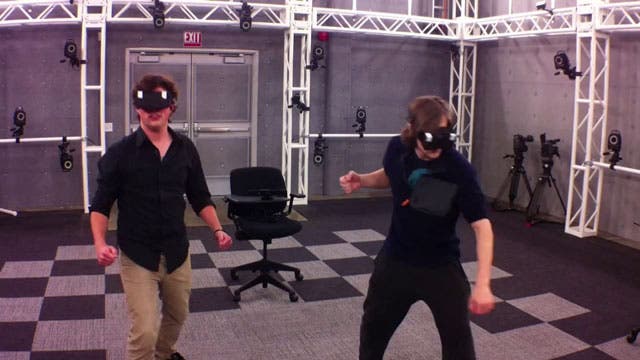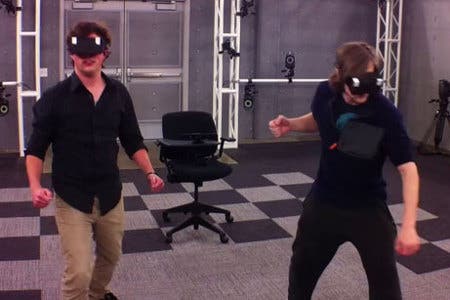Project Holodeck aims to make Star Trek gaming a reality
Uses Oculus Rift, PlayStation Move and the Razer Hyrdra.
A team at the University of Southern California is trying to make the Holodeck from Star Trek a virtual reality.
Project Holodeck aims to create full 360 degree, full body virtual reality in an accessible consumer gaming platform.
It fuses head tracking, body tracking and button inputs with vehicular locomotion and in-place locomotion (jogging on the spot to run). This, the team said, means players can move around a personal "micro" space while moving around a larger "macro" space.
Project Holodeck uses the Oculus Rift headset for head mounted video feedback, the PlayStation Move for head tracking and the Razer Hydra for body tracking.
The Oculus Rift, backed by programmer legend John Carmack, uses two lenses to amplify a 1280x800 resolution screen into two oculi. The player gets a stereoscopic 3D image with a 90-degree horizontal field of view and a 105-degree vertical field of view. Its makers say it puts the Sony HMZ-T1 "to shame".
"This isn't like watching a floating television - this is true immersion in a virtual world with simulated peripheral vision."

The PlayStation Move feeds head tracking data into the Oculus Rift, and uses the Move motion controller to create a large play space.
And the Sixense Razer Hydra is used for accurate six-axis tracking and buttons and analog sticks use. "Although the Holodeck will track parts of your body, your hands are still your most important input system and they must be tracked quickly and accurately," the team explained.
There's even haptic feedback, in the form of fans linked to the game server. These are designed to simulate the wind blowing in your hair as you pilot a vehicle.
A video game has been built using the Unity game engine to show off what Project Holodeck can do. It's called Wild Skies, a Skies of Arcadia-style game that sees two players work together to pilot an airship. To steer the ship you grip the helm with both hands and perform a side to side gesture. You have weapons, including guns and swords, which are equipped using a combination of gestures and button presses.
Where the team at the University of Southern California take the emerging tech remains to be seen.
"We see Project Holodeck as more of an arcade experience, because the space required is larger than the average space available in a consumer's home," producer James Iliff told Road to Virtual Reality.
"We plan on taking this to expos and festivals like Indiecade, Maker Faire, IGF, and others, as well as our own local showcases in Los Angeles like First Move, Demo Day, Other Worlds, etc. We could potentially license our software platform if we wanted to, and we can put together kits with our own custom hardware, but in the long run we also want to reach home users with a simpler consumer system that can fit comfortably in the living room.
"We've been talking to several big names in the industry, including Microsoft and Disney Imagineering, and there are a number of different directions we can go with it - all equally exciting!"

